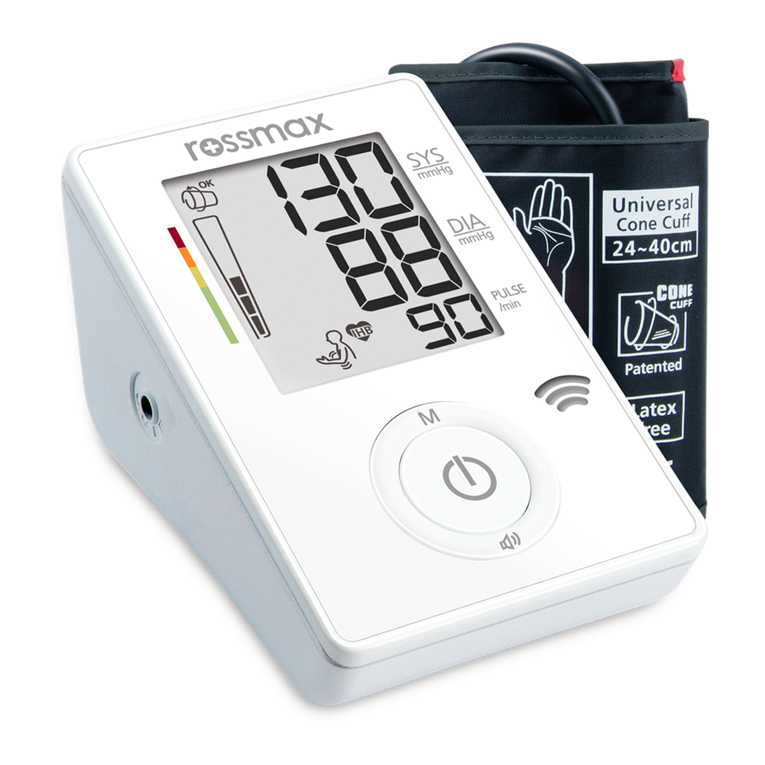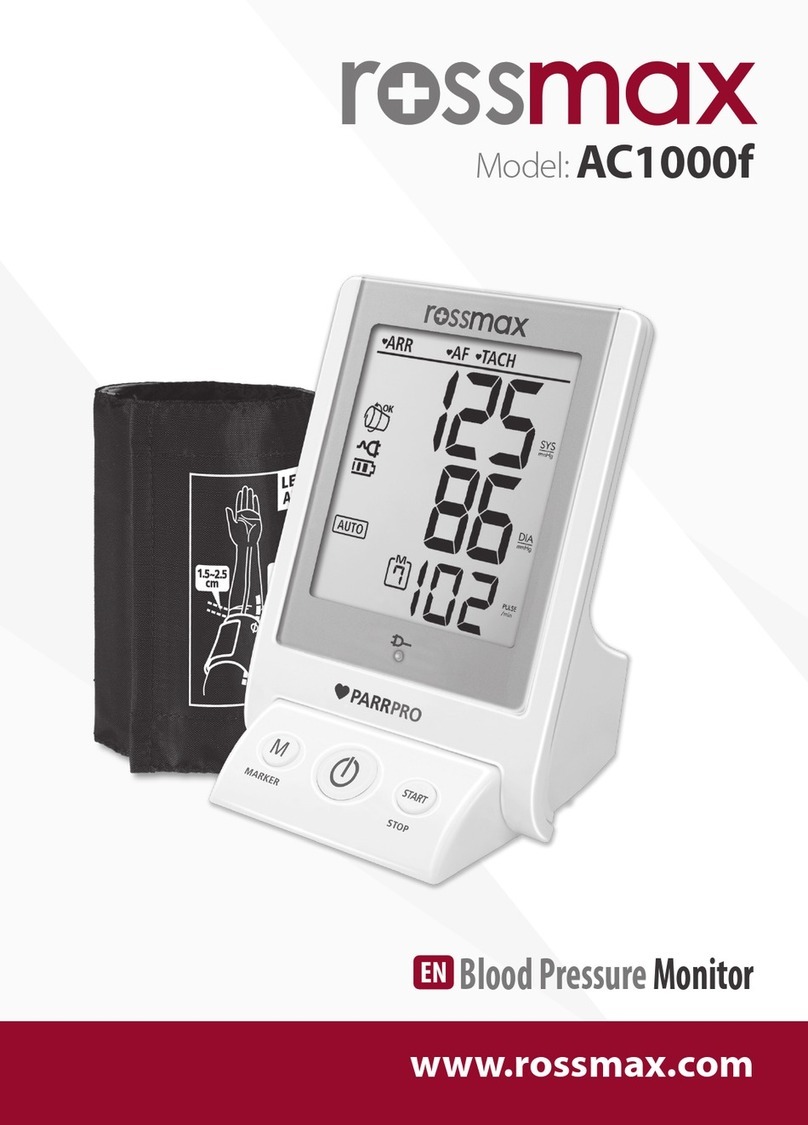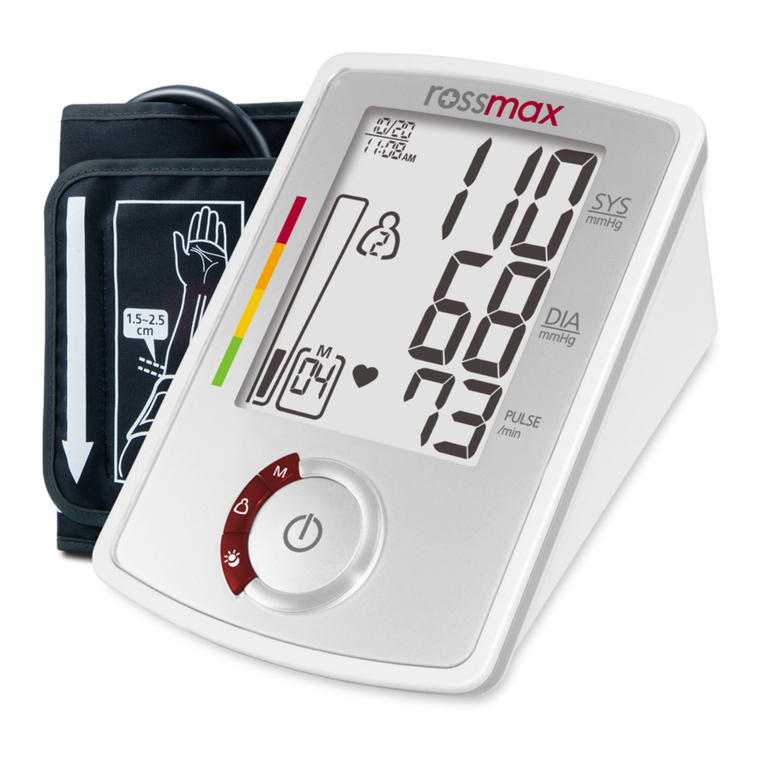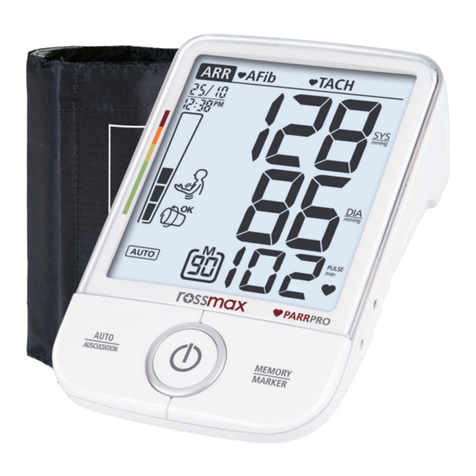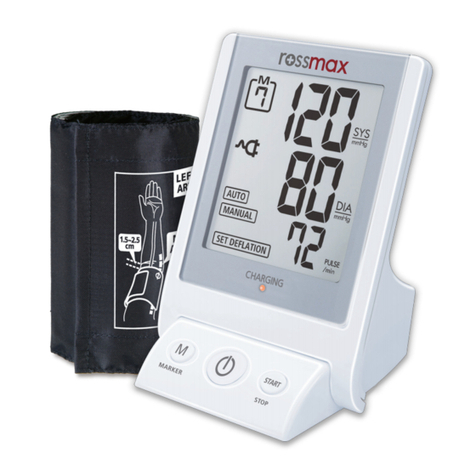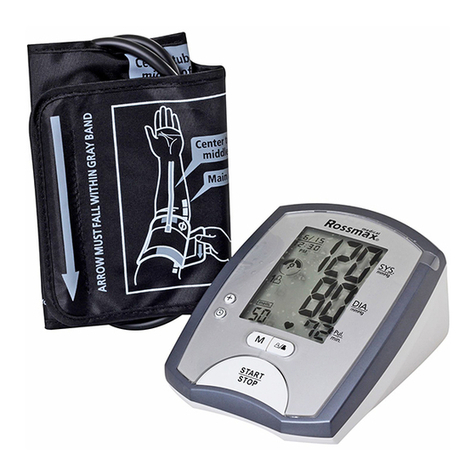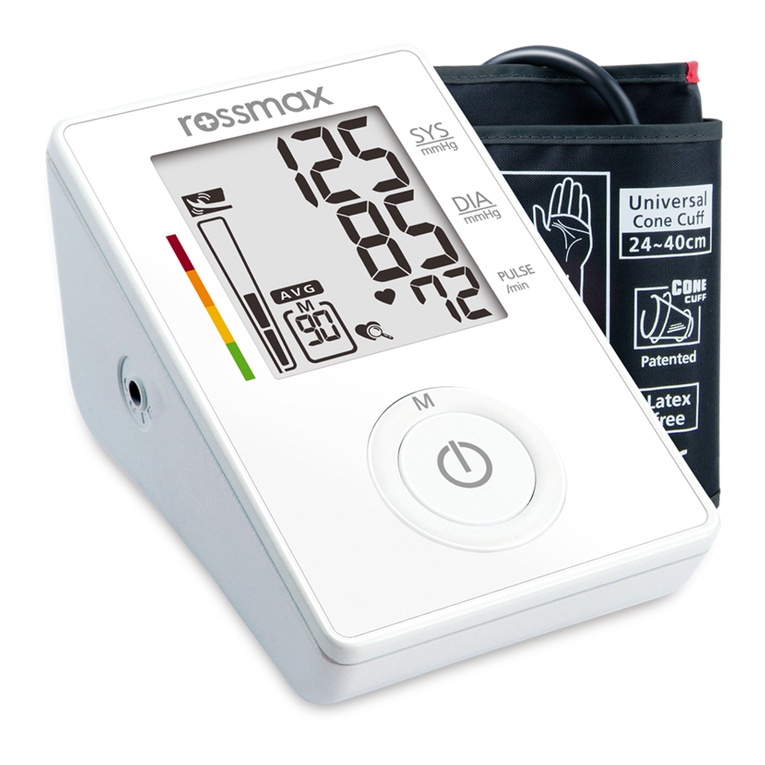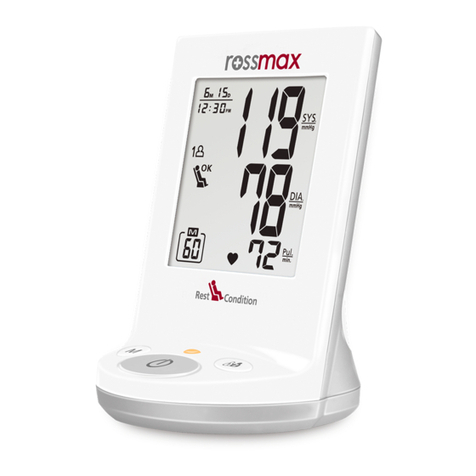1. The monitor has two memory zones (1 and 2). Each zone can store up to
60 measurements.
2. To read memory values from a selected memory zone, use the User-Switch-
ing key to select a memory zone (1 or 2) from which you want to recall
values. Press the Memory key. The first reading displayed is the average of
the last 3 measurements stored in memory.
3. Continue to press the Memory key to view the last previously stored meas-
urement. Every measurement comes with an assigned memory sequence
number.
Note: The memory bank can store up to 60 readings per memory zone. When
the number of readings exceeds 60, the oldest data will be replaced
with the new record.
16. Recalling Values from Memory
17. Clearing Values from Memory
18. Time Adjustment
19. Data Transfer to PC (Optional)
1. Press the User-Switching key to select memory zone 1 or memory zone 2.
2. Continue to press and hold the Memory key for approximately 5 seconds,
then the data in the pre-designated memory zone can be erased automati-
cally.
1. To adjust the date / time in the monitor, press the key. The display will
show a blinking number showing the month.
2. Change the month by pressing the key. Each press will increase the
number by one in a cycling manner. Press the key again to confirm the
entry and the screen will show a blinking number representing the date.
3. Change the date, the hour and the minute as described in Step 2 above,
using the key to change and the key to confirm the entries.
4.
“0” will reappear as the Blood Pressure Monitor is ready for measurement again.
Rossmax provides a free, integrated and user-friendly blood pressure
management software which can be downloaded and installed on your
computer. You may purchase a special designed USB cable in order to
connect Rossmax’s blood pressure monitor and your PC. Please visit the
website at http://www.rossmaxhealth.com for proceeding the download-
ing and installation process.
If any abnormality should arise during use, please check the following points.
EE / Measurement Error: Make sure the L-plug is securely connected to the
air socket and measure again. Wrap the cuff correctly and keep arm steady
during measurement. If the error keeps occurring, return the device to your
local distributor or service center.
E1 / Air Circuit Abnormality: Make sure the L-Plug is securely connected
to the air socket on the side of the unit and measure again. Another possible
cause can be due to the short circuit of the microphone embedded in the
cuff. If the errors still occur, return the device to your local distributor or
service center for help.
E2 / Pressure Exceeding 300 mmHg: Switch the unit off and measure
again. If the error keeps occurring, return the device to your local distributor
or service center.
E3 / Data Error: Remove the batteries, wait for 60 seconds, and reload. If
the error keeps occurring, return the device to your local distributor or service
center.
Er / Exceeding Measurement Range: Measure again. If the error keeps
occurring, return the device to your local distributor or service center.
No display when the START/STOP key is pressed: Re-insert the batteries
in the correct positions.
Note: If the unit still does not work, return it to your dealer. Under no circum-
stance should you disassemble and repair the unit by yourself.
20. Troubleshooting
1. The unit contains high-precision assemblies. Therefore, avoid extreme temperatures,
humidity, and direct sunlight. Avoid dropping or strongly shocking the main unit, and
protect it from dust.
2. Clean the blood pressure monitor body and the cuff carefully with a slightly damp, soft
cloth. Do not press.Do not wash the cuff or use chemical cleaner on it. Never use thinner,
alcohol or petrol (gasoline) as cleaner.
21. Cautionary Notes
22. Specications
IN0AD761f000000XX
Issue date: 2011/05/03
www.rossmaxhealth.com
Measurement Method Oscillometric
Measurement Range Pressure: 30-260 mmHg; Pulse: 40~199 beats/ minute
Pressure Sensor Semi conductor
Accuracy Pressure: ± 3mmHg; Pulse: ± 5% of reading
Inflation Pump Driven
Deflation Automatic Air Release Valve
Memory capacity 60 memories fro each zone x 2 zones
Auto-shut-off 1 minute after last key operation
Operation Environment 10°C~40°C (50°F~104°F); 40%~85% RH
Storage Environment -10°C~60°C (14°F~140°F); 10%~90% RH
DC Power Source DC 6V four R06 (AA) Batteries
AC Power Source
DC12V, >600mA(Plug size: outer(-) is Ø3.8, inner(+) is Ø1.3)
Dimensions 120 (L) X 121 (W) X 178 (H) mm
Weight 417g (G.W.) (w/o Batteries)
Arm circumference Adult: 24~36 cm (9.4”~14.2”)
Limited Users Adult users
: Type BF :Device and cuff are designed to provide special
protection against electrical shocks.
*Specifications are subject to change without notice.
Here are a few helpful tips to help you obtain more accurate readings:
• Blood pressure changes with every heartbeat and is in constant fluctua-
tion throughout the day.
• Blood pressure recording can be affected by the position of the user, his
or her physiological condition and other factors. For greatest accuracy,
wait one hour after exercising, bathing, eating, drinking beverages with
alcohol or caffeine, or smoking to measure blood pressure.
• Before measurement, it’s suggested that you sit quietly for at least 5
minutes as measurement taken during a relaxed state will have greater
accuracy. You should not be physically tired or exhausted while taking
a measurement.
• Do not take measurements if you are under stress or tension.
• During measurement, do not talk or move your arm or hand muscles.
• Take your blood pressure at normal body temperature. If you are feeling
cold or hot, wait a while before taking a measurement.
• If the monitor is stored at very low temperature (near freezing), have it
placed at a warm location for at least one hour before using it.
• Wait 5 minutes before taking the next measurement.
1. Press the User-Switching key to select memory zone 1 or memory
zone 2.
15. Measurement Procedures
3. Center the tube over the middle of the arm. Press
the hook and loop material together securely. Al-
low room for 2 fingers to fit between the cuff and
your arm. Position the artery mark (Ø) over the
main artery (on the inside of your arm) (Fig. 3,4).
Note: Locate the main artery by pressing with 2 fingers approximately 2 cm
above the bend of your elbow on the inside of your left arm. Identify where
the pulse can be felt the strongest. This is your main artery.
4. Plug in the cuff connecting tube into the unit (Fig. 5).
5. Lay your arm on a table (palm upward) so the cuff is at the same height as
your heart. Make sure the tube is not kinked (Fig. 6).
6. This cuff is suitable for your use if the arrow falls within the solid color line
as shown on the right (Fig. 7). If the arrow falls outside the solid color line,
you will need a cuff with other circumferences. Contact your local dealer
for additional size cuffs.
Fig.1
Fig.3
Fig.2
Fig.4
Fig.5
Fig.7
Fig.6
After a memory zone is selected, press the START/STOP key to reset
the monitor so it can start measurement in the chosen memory zone.
2. Press the START/STOP key. All digits will light up, checking the display
functions. The checking procedure will be completed in 2 seconds.
3. After all symbols appear, the display will show a blinking “0”. The
monitor is ready to measure and will automatically inflate the cuff
slowly to start measurement.
4. When the measurement is completed, the cuff will deflate entirely. Sys-
tolic pressure, diastolic pressure and pulse will be shown simultaneously
on the LCD screen. The memory sequence number will blink and the
Resting Detector symbol will appear on the display. The measurement
is then automatically stored in the memory.
If ( ) appears on the display, this means the measurement was taken
in a resting state (HSD Negative). Such measurement result can serve
as a reference for the users and will be put into the Average of the last
3 measurement calculation.
If ( ) appears on the display, the Resting Detector orange light will flash
about 6 times simultaneously. This means the measurement was taken
not in a resting state (HSD Positive) therefore such measurement result
shall be disregarded and will not be put into the Average of the last 3
measurement calculation.
If the user suffers from bradycardia or very slow heart rate, the device
may not be able to detect the HSD properly during measurement.
When this happens, the Resting Detector icon will not appear on the
LCD screen.
This monitor will re-inflate automatically to approximately 220 mmHg if
the system detects that your body needs more pressure to measure your
blood pressure.
Note: 1. This monitor automatically switches off approximately 1 minute
after last key operation.
2. To interrupt the measurement, simply press the START/STOP or
Memory key; the cuff will deflate immediately.
3. During the measurement, do not talk or move your arm or
hand muscles.
3. Leaky batteries can damage the unit. Remove the batteries when the unit is not used for
a long time.
4. The unit should not be operated by children so to avoid hazardous situations.
5. If the unit is stored near freezing, allow it to acclimate at room temperature before use.
6. This unit is not field serviceable. You should not use any tool to open the device nor should
you attempt to adjust anything inside the device. If you have any problems, please contact
the store or the doctor from whom you purchased this unit or please contact Rossmax
International Ltd.
7. As a common issue for all blood pressure monitors using the oscillometric measurement
function, the device may have difficulty in determining the proper blood pressure for
users diagnosed with common arrhythmia (atrial or ventricular premature beats or atrial
fibrillation), diabetes,poor circulation of blood, kidney problems,or for users suffered from
stroke,or for unconscious users.
8. To stop operation at any time, press the START/STOP key, and the air in the cuff will be
rapidly exhausted.
9. Once the inflation reaches 300 mmHg, the unit will start deflating rapidly for safety reasons.
10. Please note that this is a home healthcare product only and it is not intended to serve as
a substitute for the advice of a physician or medical professional.
11. Do not use this device for diagnosis or treatment of any health problem or disease.
Measurement results are for reference only. Consult a healthcare professional for
interpretation of pressure measurements. Contact your physician if you have or suspect
any medical problem. Do not change your medications without the advice of your
physician or healthcare professional.
12. Electromagnetic interference:The device contains sensitive electronic components. Avoid
strong electrical or electromagnetic fields in the direct vicinity of the device (e.g. mobile
telephones, microwave ovens). These may lead to temporary impairment of measurement
accuracy.
13. Dispose of device,batteries, components and accessories according to local regulations.
14. This monitor may not meet its performance specification if stored or used outside
temperature and humidity ranges specified in Specifications.
15.If a constant arrhythmic pattern is present (e.g. atrial fibrillation), this will mean that HSD
might become positive.
23. EMC guidance and manufacturer’s declaration
Guidance and manufacturer’s declaration-electromagnetic emissions
The AD761f is intended for use in the electromagnetic environment specied below.
The customer or the user of the AD761f should assure that it is used in such an environment.
Emission test Compliance Electromagnetic environment-guidance
RF emissions CISPR 11 Group 1 The AD761f uses RF energy only for its internal function. Therefore, its
RF emissions are very low and are not likely to cause any interference
in nearby electronic equipment.
RF emissions CISPR 11 Class B The AD761f is suitable for use in all establishments, including
domestic establishments and those directly connected to the public
low-voltage power supply network that supplies buildings used for
domestic purposes.
Harmonic emissions
IEC 61000-3-2
Class A
Voltage uctuations/icker
emissions IEC 61000-3-3
Compliance
Guidance and manufacturer’s declaration-electromagnetic immunity
The AD761f is intended for use in the electromagnetic environment specied below.
The customer or the user of the AD761f should assure that it is used in such an environment.
Immunity test IEC 60601 test level Compliance level Electromagnetic environment-guidance
Electrostatic dis-
charge (ESD) IEC
61000-4-2
± 6 kV contact
± 8 kV air
± 6 kV contact
± 8 kV air
Floors should be wood, concrete or ceramic tile.
If oors are covered with synthetic material, the
relative humidity should be at least 30%
Electrical fast
transient/burst IEC
61000-4-4
± 2kV for power supply
lines
± 1kV for input / output
lines
± 2kV for power sup-
ply lines
Not applicable
Mains power quality should be that of a typical
commercial or hospital environment.
Surge IEC 61000-
4-5
± 1kV line(s) to line(s)
± 2kV line(s) to earth
± 1kV differential
mode
Not applicable
Mains power quality should be that of a typical
commercial or hospital environment.
Voltage Dips, short
interruptions and
voltage variations
on power supply
input lines IEC
61000-4-11
<5% UT(>95% dip in
UT) for 0,5 cycle
40% UT(60% dip in
UT) for 5 cycles
70% UT(30% dip in
UT) for 25 cycles
<5% UT(>95% dip in
UT) for 5 s
<5% UT(>95% dip in
UT) for 0,5 cycle
40% UT(60% dip in
UT) for 5 cycles
70% UT(30% dip in
UT) for 25 cycles
<5% UT(>95% dip in
UT) for 5 s
Mains power quality should be that of a typical
commercial or hospital environment. If the user
of the AD761f requires continued operation
during power mains interruptions, it is recom-
mended that the AD761f be powered from an
uninterruptible power supply or a battery.
Power frequency
(50/60 Hz) mag-
netic eld IEC
61000-4-8
3 A/m 3 A/m Power frequency magnetic elds should be at
levels characteristics of a typical location in a
typical commercial or hospital environment.
NOTE: UT is the a.c. mains voltage prior to application of the test level.
Guidance and manufacturer’s declaration-electromagnetic immunity
The AD761f is intended for use in the electromagnetic environment specied below.
The customer or the user of the AD761f should assure that is used in such and environment.
Immunity test IEC 60601 test level Compliance level Electromagnetic environment-guidance
Conducted RF
IEC 61000-4-6
Radiated RF
IEC 61000-4-3
3 Vrms
150 KHz to 80 MHz
3 V/m
80MHz to 2,5 GHz
3 Vrms
3 V/m
Portable and mobile RF communications equipment
should be used no closer to any part of the AD761f includ-
ing cables, than the recommended separation distance
calculated from the equation applicable to the frequency of
the transmitter.
Recommended separation distance:
d = 1,2 √P
d = 1,2 √P 80MHz to 800 MHz
d = 2,3 √P 800MHz to 2,5 GHz
Where P is the maximum output power rating of the
transmitter in watts (W) according to the transmitter
manufacturer and d is the recommended separation
distance in metres (m).
Field strengths from xed RF transmitters, as determined
by an electromagnetic site survey, a should be less than
the compliance level in each frequency range. b
Interference may occur in the vicinity of equipment marked
with the following symbol:
Recommended separation distance between portable and mobile RF communications equipment and the AD761f
The AD761f is intended for use in an electromagnetic environment in which radiated RF disturbances are controlled. The
customer or the user of the AD761f can help prevent electromagnetic interference by maintaining a minimum distance
between portable and mobile RF communications equipment (transmitters) and the AD761f as recommended below,
according to the maximum output power of the communications equipment.
Rated maximum output
power of transmitter / W
Separation distance according to frequency of transmitter / m
150 kHz to 80 MHz / d=1,2√P 80 MHz to 800 MHz / d=1,2√P 800 MHz to 2,5 GHz / d=2,3√P
0,01 0,12 0,12 0,23
0,1 0,38 0,38 0,73
11,2 1,2 2,3
10 3,8 3,8 7,3
100 12 12 23
For transmitters rated at a maximum output power not listed above, the recommended separation distance d in metres
(m) can be estimated using the equation applicable to the frequency of the transmitter, where P is the maximum output
power rating of the transmitter in watts (W) according to the transmitter manufacturer.
NOTE 1: At 80 MHz and 800 MHz, the separation distance for the higher frequency range applies.
NOTE 2: These guidelines may not apply in all situations. Electromagnetic propagation is affected by absorption and
reection from structures, objects and people.
NOTE 1: At 80 MHz and 800 MHz, the higher frequency range applies.
NOTE 2: These guidelines may not apply in all situations. Electromagnetic propagation is affected by absorption and
reection from structures, objects and people.
a: Field strengths from xed transmitters, such as base stations for radio (cellular/cordless) telephones and land mobile
radios, amateur radio, AM and FM radio broadcast and TV broadcast cannot be predicted theoretically with accuracy.
To assess the electromagnetic environment due to xed RF transmitters, an electromagnetic site survey should be
considered. If the measured eld strength in the location in which the AD761f is used exceeds the applicable RF com-
pliance level above, the AD761f should be observed to verify normal operation. If abnormal performance is observed,
additional measures may be necessary, such as re-orienting or relocating the AD761f.
b: Over the frequency range 150 kHz to 80 MHz, eld strengths should be less than 3 V/m.

